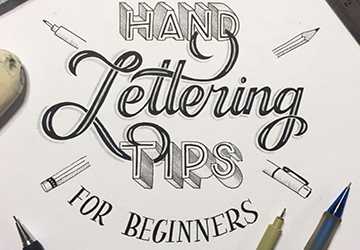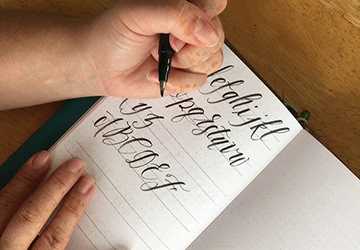How to Perfect Your Hand Lettering Skills
Author: samreen
In today's digital age, where keyboards and touchscreen devices dominate our daily communications, there's something incredibly captivating about the art of handwriting. This skill allows you to bring personality and creativity to the written word, transforming simple text into a work of art.
Whether you're a budding artist or just looking for new creative outlets, hand lettering offers a rewarding and visually appealing way to express yourself. In this article, we'll explore the fascinating world of hand lettering and provide valuable techniques and tips to help you perfect your hand lettering skills.
The art of hand lettering
Before we delve into the techniques and techniques, let's take a moment to understand the artistry of hand lettering. Script fonts are more than just handwriting; It is an elaborate art form that involves designing and drawing letters in a beautiful and visually impactful way.
Each letter is a unique work of art, and when combined, they can create stunning creations, from inspirational quotes to wedding invitations.

Materials and Tools
You will need basic materials and tools to start your hand lettering adventure. Here's what you need to get started:
Quality paper: Start with smooth, high-quality paper suitable for your medium of choice, whether it's markers, pens, or watercolors. Good shape prevents feathering and bleeding and makes your lettering look crisp.
Pens and Markers: Shop for pens and markers with different nib sizes and styles. Brushes, fine liners, and calligraphy pens are essential to improve handwriting further.
Pencil and Eraser: Sketching your design before inking is a crucial step. Use a pencil to draw a rough outline and an eraser to make corrections.
Rulers and T-squares: These tools help you maintain straight lines and precise angles in your lettering, especially when working with more structural styles.
Ink or Color: Depending on your preference, choose an ink or color that matches your paper and achieves the desired effect.
Learn the basics
Practicing and learning basic techniques before creating complex handwritten pieces is essential. These include the following:
Strokes and Lines: Start with simple strokes and lines to get familiar with your tools—practice making thin upward strokes and thick downward strokes by applying different pressures to the pen or paintbrush.
Letter Shapes: Study different letter shapes and styles. Familiarity with serif and sans-serif fonts, calligraphy fonts, and decorative fonts. Each category has unique characteristics, and understanding these characteristics will allow you to create diverse designs.
Consistency: Consistency in handwriting is crucial. Ensure your letters have consistent height, width, and spacing for an elegant look. Guides or grid paper can help maintain consistency.
Letter Spacing: Pay attention to the spacing between letters and words. Proper spacing is essential for readability and aesthetics. Experiment with different letter spacings to find what works best for your design.
Letter Joining: In some styles, letters join each other to create a smooth font - practice letter joining to create a seamless look in your font.
Serifs and Swashes: If you are interested in serif fonts or want to add decorative elements, practice these swashes individually before incorporating them into your designs.
Sketching and Composition
Once familiar with basic strokes and letter shapes, it's time to move on to sketching and composition. This involves planning your article and creating a rough sketch before inking it. Here are some tips for effective sketching and design:
Plan your layout:
1. Decide on the size and direction of the piece.
2. Consider whether it is a standalone word or a more detailed reference.
3. Draw the overall composition on paper, including any decorative elements and embellishments.
Typographic hierarchy: If your article contains multiple words or phrases, create an order by varying the size, style, or weight of certain words to emphasize key points.
Grids and Guides: Use grids or guides to maintain consistent letter size, spacing, and alignment. This step is crucial for complex and structured pieces.
Start with pencil: Start with a light pencil sketch to outline your design. Don't worry about making mistakes. You can permanently delete and refine drawings as needed.

Coloring and Finishing
Once you're happy with your pencil sketch, use ink to bring your handwriting to life. Here are some tips for coloring and perfecting your artwork:
Use the right tools: Choose the right pen, marker, or brush for your design. A brush is excellent for drawing thick and thin strokes, while a thin eyeliner removes precise details.
Start with an outline: Outline your letters and any decorative elements. This helps define the structure of the design.
Fill: After outlining the letters, fill them in with the ink or color of your choice. Take your time to ensure even coverage and consistent thickness of your strokes.
Add shadows and highlights: To add depth and dimension to your font, consider adding shadows and highlights. Clouds can be calculated on one side of each letter, while highlights can be added on the other for a 3D effect.
Clean up the edges: Using an eraser removes stray pencil marks or smudges. Your font should look clean and smooth.
Practice and make progress
Hand lettering requires constant practice and unwavering dedication to hone your skills like any artistic endeavor. Here are some tips for ongoing training and development:
Challenge yourself: Try new styles, fonts, and compositions to challenge yourself and expand your skills.
Study the Work of Others: Study the work of experienced hand lettering artists. Analyze their technique, style, and composition for inspiration and insights.
Criticize your work: Criticize your work. Identify areas where you can improve and work on them systematically.
The joy of handwriting fonts
All in all, hand lettering is an enjoyable and fulfilling skill that combines artistry and communication. You can perfect your handwriting skills and create beautiful and expressive art with the right tools, practice, and dedication. Remember, hand lettering isn't just about creating visually appealing text; It's about conveying meaning, emotion, and story through your art.
So have fun hand lettering, experimenting, and using your creativity as you perfect your craft. Whether you're a beginner or an experienced artist, there's always something new to discover and explore regarding handwriting.







